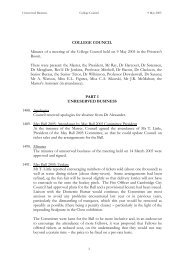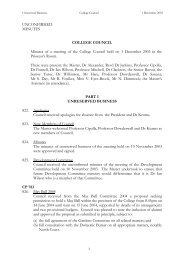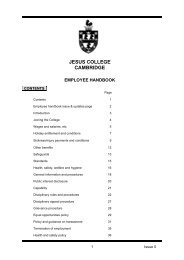2012 Annual Report - Jesus College - University of Cambridge
2012 Annual Report - Jesus College - University of Cambridge
2012 Annual Report - Jesus College - University of Cambridge
You also want an ePaper? Increase the reach of your titles
YUMPU automatically turns print PDFs into web optimized ePapers that Google loves.
Understanding Large Scale Structure<br />
in our Universe<br />
Bill Saslaw<br />
ASTROPHYSICS I <strong>Jesus</strong> <strong>College</strong> <strong>Annual</strong> <strong>Report</strong> <strong>2012</strong> 17<br />
The age-old question “Where are we in our universe?” has been superseded in the 21st<br />
century by asking “Where is everything in the universe?” Nowhere is a special part <strong>of</strong><br />
space singled out for us. Earth is a minor planet orbiting an undistinguished star in an<br />
ordinary spiral galaxy within a typical group <strong>of</strong> three dozen or so other spiral, elliptical<br />
and irregular galaxies. Astronomers have known this for nearly a century.<br />
What is new, however, is a combination <strong>of</strong> conceptual changes and powerful telescopes.<br />
These have revealed the general distribution <strong>of</strong> matter in our universe – its large-scale<br />
structure. The location <strong>of</strong> anything in the universe must be understood relative to the<br />
locations <strong>of</strong> everything else. In the early decades <strong>of</strong> the 20th century, astronomers had a<br />
fairly simple picture in which there was a universal sea <strong>of</strong> galaxies, distributed mostly<br />
uniformly with here and there a huge gravitationally bound cluster. People debated the<br />
percentage <strong>of</strong> galaxies that were clustered versus those distributed more smoothly.<br />
This picture began to crumble about four decades ago. Small galaxy clusters were found<br />
inside larger ones; larger ones <strong>of</strong>ten combined to form irregular superclusters. There is a<br />
whole hierarchy <strong>of</strong> galaxy clustering and it has a very particular continuous structure.<br />
A structure so unexpected that many cosmologists thought it must have arisen<br />
mysteriously in the big bang – the very hot enormously dense stage <strong>of</strong> the early universe<br />
about 14 billion years ago. Astronomers quickly proposed half a dozen or so exotic theories<br />
to account for this structure; most <strong>of</strong> these theories turned out to be more ephemeral than<br />
the big bang itself.<br />
From first principles it was obvious that gravity must play a major role in galaxy<br />
clustering. All matter gravitates. Although gravity is a weak force compared to the nuclear<br />
force and electromagnetism, gravity always attracts and does not saturate. There are no<br />
known local anti-gravity forces. (Interestingly, our own perception <strong>of</strong> gravity is also the<br />
only human sense which does not saturate.) But what was missing in our understanding<br />
<strong>of</strong> gravity was how very large numbers <strong>of</strong> gravitating objects – each <strong>of</strong> them a galaxy<br />
binding billions <strong>of</strong> stars – would behave in an expanding universe. Newton had calculated<br />
how two small masses would orbit each other. His successors had spent more than a<br />
century trying to understand how three or four gravitating point masses would behave.<br />
Now we are faced with understanding the gravitational behaviour <strong>of</strong> billions <strong>of</strong> these<br />
galaxies.<br />
Fortunately we do not need to understand the behaviour <strong>of</strong> systems containing many<br />
objects in such great detail as systems with smaller numbers, like the Sun’s planets.<br />
To ask “Which galaxies are where at a given time?” is sometimes interesting, but not always<br />
as interesting as discovering new unexpected general phenomena that emerge from the<br />
interactions <strong>of</strong> many galaxies. One <strong>of</strong> these general phenomena is their distribution in our<br />
expanding universe.<br />
Calculation, computation and observation combine to lead us to an understanding <strong>of</strong><br />
how galaxies distribute themselves throughout our universe. Calculation, <strong>of</strong>ten called<br />
theory, starts with the known gravitational interactions <strong>of</strong> galaxies, adds their modification<br />
by the expansion <strong>of</strong> space – time, and derives statistical properties <strong>of</strong> their distribution.<br />
Statistical, because that is the best we can do with available mathematical techniques.













